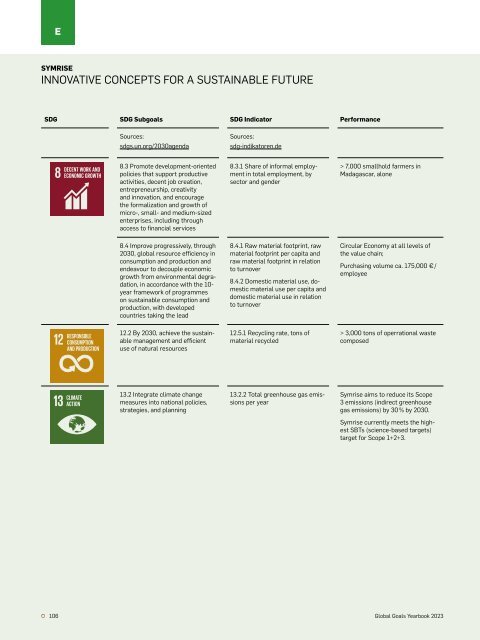Global Goals Yearbook 2023 makes SDG impact measurable
No poverty, no hunger, peace: In 2015, the United Nations adopted the 17 Sustainable Development Goals, which were supposed to make the world a better place by 2030. Now it is half-time. The results are sobering. In the remaining time, measures must be more targeted and more effective. On the occasion of COP28 in Dubai, the Global Goals Yearbook is focusing on the aspect of impact.
No poverty, no hunger, peace: In 2015, the United Nations adopted the 17 Sustainable Development Goals, which were supposed to make the world a better place by 2030. Now it is half-time. The results are sobering. In the remaining time, measures must be more targeted and more effective. On the occasion of COP28 in Dubai, the Global Goals Yearbook is focusing on the aspect of impact.
You also want an ePaper? Increase the reach of your titles
YUMPU automatically turns print PDFs into web optimized ePapers that Google loves.
E<br />
SYMRISE<br />
INNOVATIVE CONCEPTS FOR A SUSTAINABLE FUTURE<br />
<strong>SDG</strong> <strong>SDG</strong> Subgoals <strong>SDG</strong> Indicator Performance<br />
Sources:<br />
sdgs.un.org/2030agenda<br />
Sources:<br />
sdg-indikatoren.de<br />
8.3 Promote development-oriented<br />
policies that support productive<br />
activities, decent job creation,<br />
entrepreneurship, creativity<br />
and innovation, and encourage<br />
the formalization and growth of<br />
micro-, small- and medium-sized<br />
enterprises, including through<br />
access to financial services<br />
8.3.1 Share of informal employment<br />
in total employment, by<br />
sector and gender<br />
> 7,000 smallhold farmers in<br />
Madagascar, alone<br />
8.4 Improve progressively, through<br />
2030, global resource efficiency in<br />
consumption and production and<br />
endeavour to decouple economic<br />
growth from environmental degradation,<br />
in accordance with the 10-<br />
year framework of programmes<br />
on sustainable consumption and<br />
production, with developed<br />
countries taking the lead<br />
8.4.1 Raw material footprint, raw<br />
material footprint per capita and<br />
raw material footprint in relation<br />
to turnover<br />
8.4.2 Domestic material use, domestic<br />
material use per capita and<br />
domestic material use in relation<br />
to turnover<br />
Circular Economy at all levels of<br />
the value chain;<br />
Purchasing volume ca. 175,000 € /<br />
employee<br />
12.2 By 2030, achieve the sustainable<br />
management and efficient<br />
use of natural resources<br />
12.5.1 Recycling rate, tons of<br />
material recycled<br />
> 3,000 tons of operrational waste<br />
composed<br />
13.2 Integrate climate change<br />
measures into national policies,<br />
strategies, and planning<br />
13.2.2 Total greenhouse gas emissions<br />
per year<br />
Symrise aims to reduce its Scope<br />
3 emissions (indirect greenhouse<br />
gas emissions) by 30 % by 2030.<br />
Symrise currently meets the highest<br />
SBTs (science-based targets)<br />
target for Scope 1+2+3.<br />
106 <strong>Global</strong> <strong>Goals</strong> <strong>Yearbook</strong> <strong>2023</strong>
















